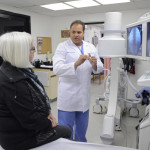Pain Surgeon Dr. Nameer Haider First in World to Perform “Halo360® “ Cranial Neurostimulator Procedure for Treatment of Migraine Headaches using BSC Spectra System
Revolutionary Migraine treatment is Less Invasive, provides better pain coverage, results in faster recovery using 32 contact Boston Scientific Spectra System
Nameer Haider, M.D., has begun performing 360 Degree Neurostimulator Implantations to treat chronic headaches using the Boston Scientific Spectra System. Dr. Haider, a board certified interventional pain surgeon, is the first in the world to successfully perform and offer this procedure to patients.
The 360 degree Halo migraine procedure is a revolutionary innovative surgical technique that provides long-lasting relief for people who suffer from chronic, debilitating headaches. The procedure is based on neurostimulation, which has been used for more almost 50 years to treat chronic pain.
Combined Supraorbital/Supratrochlear, Auriculotemporal, and Greater/Lesser Occipital Neurostimulation delivers a small electrical charge over 12 separate nerves through an implanted device using 32 tiny electrodes, similar to a pacemaker. The Spectra System has a customized electrical pattern and can be self-adjusted via wireless remote control. Initially, temporary leads are placed in an outpatient office based procedure to confirm the device will control the patient’s headaches. Permanent leads are then implanted a few weeks later, followed by a short recovery period. No other neurostimulator system can control pain of the entire head (360 degrees).
Benefits of the Haider Halo360® Procedure include:
- Smaller incision
- More Pain coverage than alternative systems and procedures
- No need for extra surgery and incisions to place lead extensions
- No hospitalization required, Rapid Recovery
- The only 32 contact system available, essentially double the stimulation capacity and coverage of any other system
“Key to this procedure is the 32 contact Spectra System. During surgery, the system provides both the surgeon and patient with real-time visual, tactile and auditory feedback which optimizes implant positioning and pain control. It helps the surgeon optimally place the implant which is crucial to achieving optimal sustained pain relief after surgery,” Dr. Haider said.
Proper implant alignment and precise positioning during surgery, which the Spectra System provides can improve the procedure’s effectiveness.
According to Dr. Haider, in the past, neurostimulator systems used only had 16 stimulation contacts. If patients required more areas of coverage such as the front, sides, and back of the head on both sides, older systems would require the implantation of more leads, more lead extensions, and 2 separate internal pulse generator batteries. The Spectra system is the only one in the world that can power 32 contacts with one battery, effectively like having two of the other systems in one small sized generator without the need for any lead extensions. This means more powerful pain coverage in more locations with just one system, at the same time requiring fewer incisions and less invasive surgery.
There are currently 28 million migraine sufferers in the United States. Nearly one in four households has at least one migraine sufferer. “Prevalence is highest in the 25–55 age group, which hinders people during their most productive years of life” Dr. Haider said


